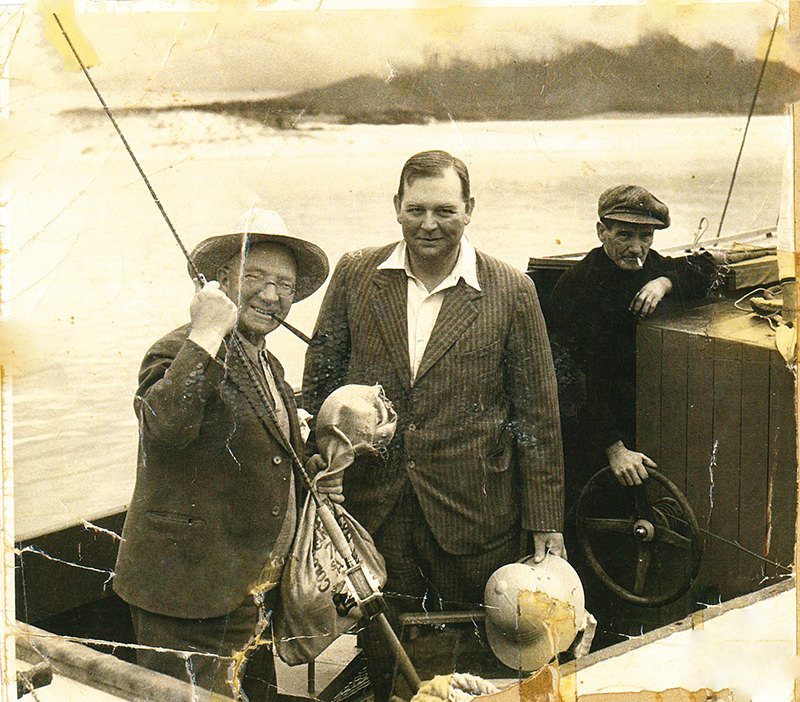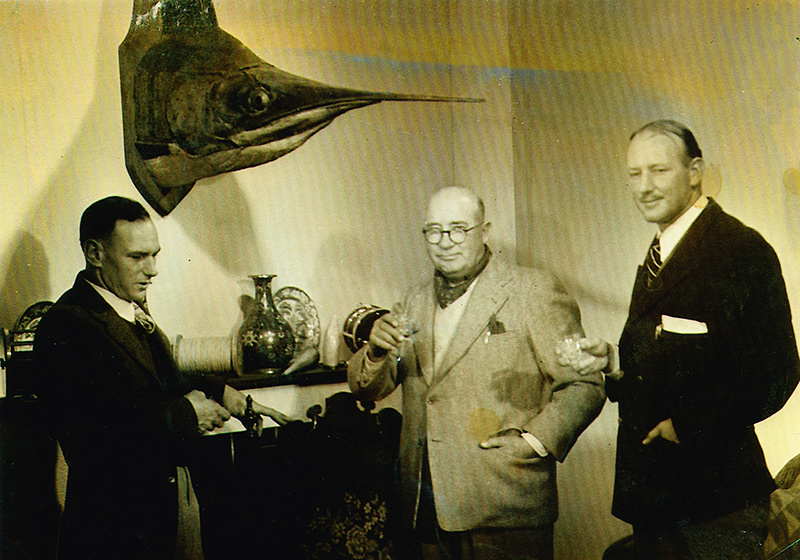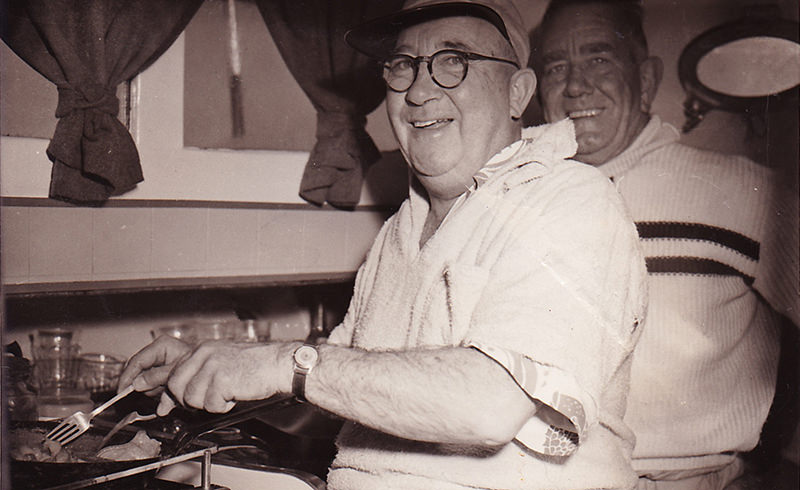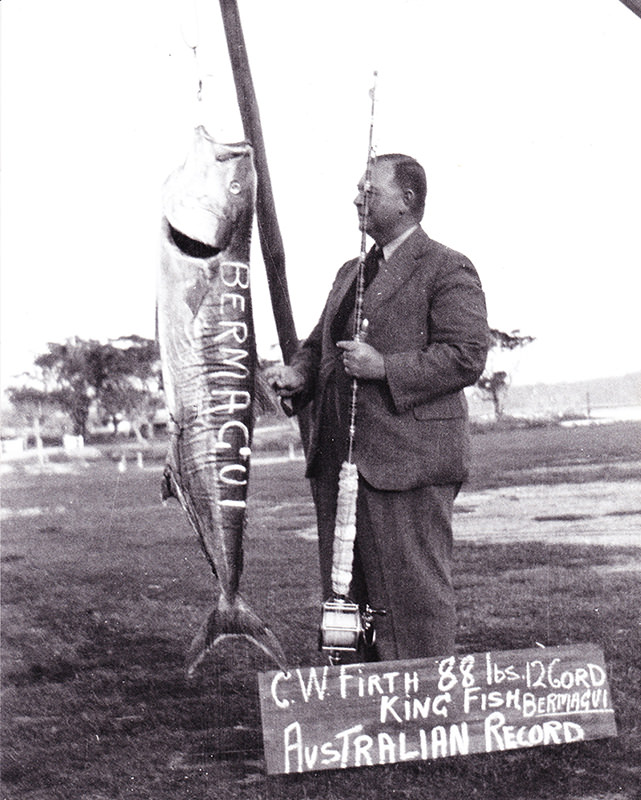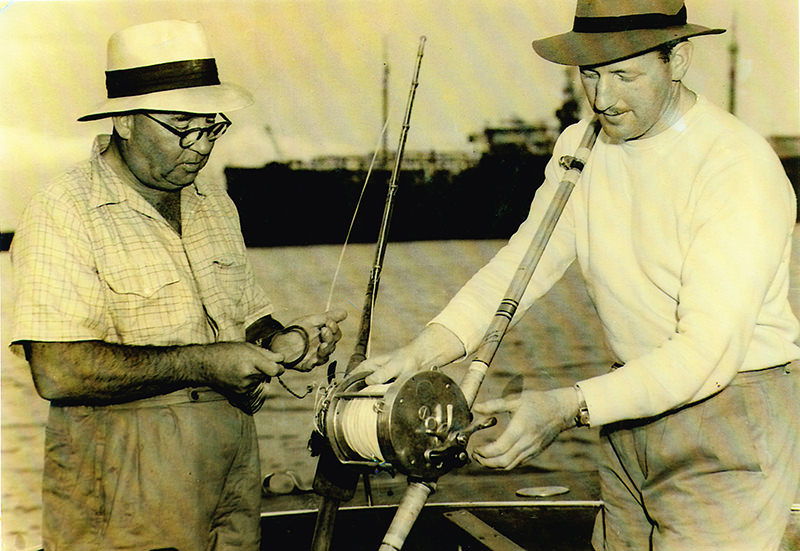“New Big Game Angling Association Formed in New South Wales”, proclaimed articles in the sporting press in July 1938. The reports continued, “an important development in big game angling affairs in New South Wales took place on June 22nd 1938, when, at a Conference of game fishing clubs convened by the New South Wales Rod Fishers’ Society, a new body was formed to control and foster game fishing in that State. The name of the new organisation is the New South Wales Game Fishing Association (NSWGFA) and consists of delegates appointed by affiliated Clubs”.
The popularity and growth of the sport from the early 1930’s had been phenomenal, due in large part to the efforts of a number of pioneer anglers: Clive Firth, Reg Lyne, Errol Bullen, Theo Roughley, Les Winkworth, Sil Rohu, Gordon Allard, Les Brookes and Max Lawson being the leading figures. The visit to Australia by the famous US author and angler Zane Grey in 1936 had provided further impetus to the sport. Grey wrote glowingly of the fishing to be had at Bermagui, Batemans Bay and Sydney and his party’s every success was widely publicised by his smooth , well- oiled publicity machine in the popular and sporting press.
By 1938, eighteen Clubs had been established along the coast: Batemans Bay Game Fishing Club, Bellinger River Amateur Anglers Club, Bermagui Big Game Anglers Club, Eden Twofold Bay Big Game Anglers Club, Huskisson Big Game Fishing Club, Illawarra Game Fish Club, Jervis Bay Game Fishing Club, Kempsey and Macleay River Big Game Angling Club, Lismore Angling Club, Merimbula Big Game and Lakes Angling Club, Milton and Ulladulla Big Game Fishing Club, The Anglers Club of Narooma, Newcastle Shark and Swordfish Club, North Coast Big Game Fish Club, Port Hacking Rod Fishermen’s Society, New South Wales Rod Fishers Society and the New South Wales and Barrier Reef Angling Club.
The NSW Rod Fishers Society (RFS), formed in 1904, had been the parent body and, at considerable expense, had provided the administration for the sport in the State. The rapid growth of game fish angling had progressively burdened the RFS and at the instigation of the RFS President Clive W Firth, a meeting was convened of all Clubs to establish a self-contained and independent controlling body.
Mr Firth was elected foundation President of the NSW Game Fishing Association at the June 22nd 1938 meeting. This meant that Firth was now the President of NSWGFA, The NSW Rod Fishers Society and the Big Game and Rod Fishers Association of Australia. The latter body was renamed the Game Fishing Association of Australia (GFAA) on 30th June 1938. Mr Firth was subsequently the joint founder of The International Game Fish Association (IGFA) with Mr Michael Lerner and Dr William K Gregory of USA. IGFA was formally established in June 1939.
To say that Clive Firth was the most significant figure in pre-World War 2 game fishing in Australia is to state the obvious. Present day participants owe him a great debt of gratitude for his untiring work in establishing the framework and administration for the ordered and ethical angling that we enjoy today.
NSW Game Fishing Association quickly set up an efficient administration, appointing Sydney chartered accountant and keen angler Jack Folkard as Secretary. The NSW Rod Fishers Society generously donated a number of trophies originally deeded to them, as trophies for competition throughout the NSW membership to ensure continuity with awards for meritorious catches.
At the behest of several Newcastle and Port Stephens members, a competition between anglers from that area and Sydney anglers representing NSWGFA was held in 1939. Results were mediocre but high hopes were held for far better results at the next event, scheduled for 1940. Unfortunately the declaration of World War 2 in September 1939 put the return match, and indeed game fishing, into limbo for seven long years.
Things started to move again in 1946, and at the commencement of the 1947 season Clive Firth stood down as President having taken on a caretaker role for the duration of the War. Jack Kelly, an experienced and keen angler member of Rod Fishers Society was elected to the position. Due to the effects of the War on resources and personnel, the majority of the pre- World War 2 Clubs had become defunct. Those still existing were: NSW Rod Fishers Society, Bermagui Big Game Anglers Club and Newcastle and Port Stephens Game Fish Club (formerly named the Newcastle Shark and Swordfish Club). NSW Game Fishing Association now assumed a “club” function during the period of re-building of the sport. The sport’s loss of members, suitable vessels and equipment due to the war effort was significant. The continuing commitment of anglers and administrators such as Max Lawson, Bill Southam, Jack Kelly, Milton Kent, Athel DÓmbrain, Les Winkworth and Ted Smout ensured that the sport grew to new levels over the next ten years.
The remarkable post War growth led to the decision in 1952 to re-establish the NSW Game Fishing Association as a federation of Clubs, co-ordinating the activities and acting as advocate for all NSW game fishermen and women. This led directly to the structure of the incorporated organisation that we know today as NSWGFA. Anglers residing in the Sydney area in 1952 moved to form a new Club, Sydney GFC, with the leading angler of the day, Max Lawson, as first President.
NSWGFA, as part of its continuing promotion of the sport, has for 52 years conducted the Inter-Club Tournament at Port Stephens. The event attracts anglers and boats from all over the State and, indeed, from all over Australia. Club teams, in multiples of five vessels, are nominated by the individual organisations and fierce but friendly rivalry is the hallmark of the annual events, whether in the capture or tag and release categories. The latter is now the most dominant section and many outstanding scores have been recorded. In the capture section, the heaviest marlin ever weighed in the event is Lake Macquarie GFC angler Steve Norris’ blue marlin of 340.5 kg (748 lb) caught from Graham McCloy’s “Inkwazi” in 2002. Heaviest shark honours are held by the Broken Bay GFC angler Bob Woodcock with his 785 kg (1727 lb) white pointer shark taken in 1981 from his boat “La Fuzz”.
The State Association maintains NSW record charts for all sections, including Juniors and Small-Fry and many of the present records are also Australian marks, with a number of World records in the International Game Fish Association (IGFA) listings.
New South Wales Game Fishing Association has a proud history of achievements and service to the sport and has been fortunate to have had the services of dedicated and skilled administrators and outstanding officers over the many years of its existence. In eras of constant change, the Association has provided, and continues to provide, support and leadership via its democratic structure for the benefit of the member Clubs and their members.
John McIntyre
NSWGFA Official Historian
November 2014.
